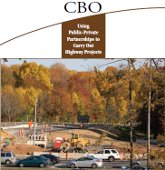2/2/2012
Congressional Budget Office: Toll Roads Are Not Free MoneyGovernment report shows that tolling relies on complicated financing models to hide the costs and risks that are passed along to the public.

Toll roads are all the rage with politicians across the country. Both Democratic and Republican lawmakers see "public-private partnerships" as the solution to their transportation funding difficulties by turning to the private sector to pay for infrastructure improvements through tolling. A report released last month by the non-partisan government analysts at the Congressional Budget Office (CBO) found the purported benefits of this financing mechanism were mostly illusory, as taxpayers end up paying roughly the same amount either way.
"The case is sometimes made that using funds from private capital markets to finance roads can increase the resources available to build, operate, and maintain roads," the CBO report stated. "But the sources of revenues available to pay for the cost of a highway project -- whether it uses the traditional financing approach or a public-private partnership -- are the same: specifically, tolls paid by users or taxes collected by either the federal government or by state and local governments. Therefore, absent restrictions on governments' ability to borrow, there is no difference between the amount those governments could raise themselves and the sums that public-private partnerships could raise because the same resources are available to remunerate investors in either case."
CBO found that private projects do hold an advantage in finishing projects on time and in the most cost-effective manner since the private firm's profits depend on the road opening as soon as possible so that the tolling revenue can begin flowing. Cost overruns generally come out of the pockets of the private companies, whereas traditional public transportation bureaucracies tend to be less cautious in monitoring and controlling how tax dollars are spent. Labor costs are generally 25 to 40 percent lower for private projects not bound by pricey labor union contracts. Only a superficial and incomplete analyses, however, conclude that the private financing model has a distinct cost advantage when all factors are considered, CBO found.
"In order to properly assess the difference in costs between securing financing through the traditional approach (generally as public debt) and obtaining it by private means, it is necessary to account not only for the interest paid on money borrowed for the project but also for the costs associated with the risks borne by taxpayers and the costs of financial transfers -- in the form of subsidized interest rates and advantageous tax treatment -- from the federal government to states and localities," the report explained. "If such a comprehensive measure is used, the costs of private and public financing are roughly comparable."
CBO analyzed the 21 toll road projects that have been completed in the US over the past twenty years at a cost of $16 billion. Though this is a small amount compared to the $1 trillion spent on roads over the same period, it accounts for 30 to 40 percent of new highway capacity. The rush to tolling began in 2008, and the real-world effect has then most tolled highways were built upon faulty models that overestimated traffic levels and tolling receipts. As a result, many of the projects went bankrupt, including the Camino Colombia Bypass in Texas, the Southern Connector in South Carolina and the South Bay Expressway in California. The public was frequently left paying for the mistake.
"The South Bay Expressway, which had received some financing from the federal TIFIA program, illustrates what can happen to taxpayers as the ultimate equity holders," the report explained. "The project filed for Chapter 11 bankruptcy in March 2010, finally emerging in May 2011. The new financing and ownership structure required by the bankruptcy court imposed a loss of 42 percent on federal taxpayers, replacing the original TIFIA investment with a package of debt and equity worth only 58 percent of the original investment."
The costs are also passed along to the motorist. On the Chicago Skyway in Illinois, tolls fell in real terms by 25 percent from 1989 to 2004 while under public control. Under private control since 2005, they have increased 60 percent.
A copy of the report is available in a 4.5mb PDF file at the source link below.


